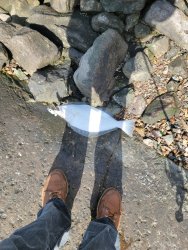Tide: is a 4/6/21 9:10am 1hr into the outgoing
Area: Alameda Harbour Bay shoreline
Gear: 7ft ugly stik lite, 10lb braid with a 12lb mono topshot. Daiwa bg2500.
3/8 jig with swimbait
3/8 hair raiser
Strolled to one of my fav spots as I was in the EB for a appt. Had a few hours to kill and I ended up catching one shaker striper, but I also foul hooked a bat ray which took me on a magic carpet ride.
Hooked a almost keeper butt, but it seemed too small so back in the bay she went. Both lures seemed to work today, but they seemed to have preferred a yoyo retrieve with a distinct pause. Both fish hit on the pause.
All in all a great day out.
Area: Alameda Harbour Bay shoreline
Gear: 7ft ugly stik lite, 10lb braid with a 12lb mono topshot. Daiwa bg2500.
3/8 jig with swimbait
3/8 hair raiser
Strolled to one of my fav spots as I was in the EB for a appt. Had a few hours to kill and I ended up catching one shaker striper, but I also foul hooked a bat ray which took me on a magic carpet ride.
Hooked a almost keeper butt, but it seemed too small so back in the bay she went. Both lures seemed to work today, but they seemed to have preferred a yoyo retrieve with a distinct pause. Both fish hit on the pause.
All in all a great day out.
Attachments
-
1.3 MB Views: 20

